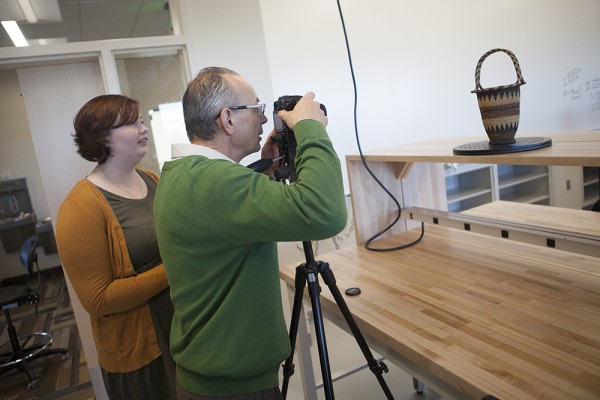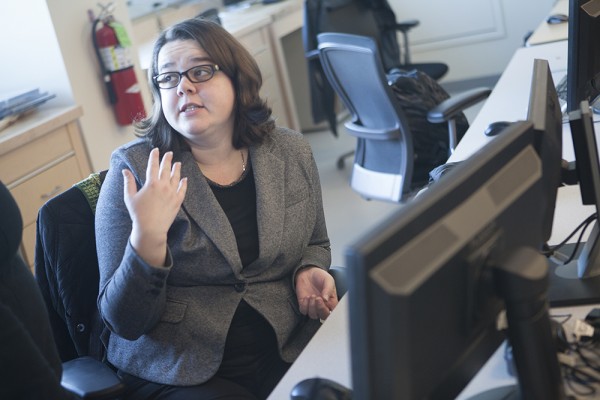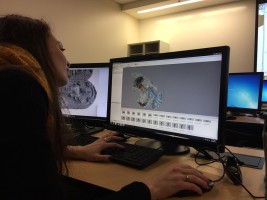Bringing it all back home: Learning a new way to highlight Alaska Native culture
by Tracy Kalytiak |
"When I carried the object out of its place no one interfered, but if only one of the true warriors of that clan had been alive the removal of it would never have been possible. I took it in the presence of aged women, the only survivors in the house where the old object was kept, and they could do nothing more than weep when the once highly esteemed object was being taken away to its last resting place."
Louis Shotridge, a Tlingit man from Klukwan who became a University of Pennsylvania Museum curator 100 years ago, explained in a journal entry how he took a shark helmet from his own clan-the "only one of its kind"-after buying it from a Kaagwaantaan clan member for $350 in 1929.

Professor Gennady Gienko helps Josie Oliva photograph a basket during a 3D-imaging workshop-a collaboration between the UAA engineering and anthropology departments. (Photo by Philip Hall / University of Alaska Anchorage)
"It is true that the modernized part of me rejoiced over my success in obtaining this important ethnological specimen for the Museum, but, as one who had been trained to be a true [Kaagwaantan], in my heart I cannot help but have the feeling of a traitor who has betrayed confidence."
Merging two disciplines
That walrus-hide shark helmet is back, on loan at the Alaska State Museum in Juneau until competing claims from two factions of the clan resolve their dispute, but other Alaska Native artifacts are stored in museums far from their Alaska origins.
While a federal law ordered the return-"repatriation"-of many Alaska Native and American Indian cultural items to their places of origin, too many still remain out of reach for the descendants of the people who made them, used them, cherished them as sacred cultural touchstones.
A new collaboration between UAA's anthropology and geomatics departments is training students to create three-dimensional (3D) photos of art and artifacts like these, which could be used to help communities that can't access the original objects but want to maintain their connection with culture, revive it or ignite ideas that can lead to new culturally inspired creations.
Dr. Gennady Gienko, a UAA geomatics professor, and Dr. Medeia Csoba DeHass, a UAA assistant professor of anthropology and Alaska Native studies, are spearheading a cooperative effort that germinated in 2011, when Gienko successfully sought UAA Center for Community Engagement and Learning funding (with a support letter from Sealaska Heritage Institute) to develop 3D modeling techniques for Alaska Native cultural items and art objects.

Dr. Medeia Csoba DeHass, pictured here, and Dr. Gennady Gienko collaborated to present a series of 3D-imaging workshops for anthropology faculty, staff and students. (Photo by Philip Hall / University of Alaska Anchorage)
Anthropology has intrigued Gienko since 2005, when one of his colleagues at a university in the South Pacific involved him in archaeological-anthropological studies requiring site excavations.
"We did field surveying and mapping of a site of [an] early people settlement," Gienko said. "The task was to reconstruct a precise 3D model of this site, to model sea level that supposedly was there 1,500 years ago, which would help to find out details about the lifestyle of those people who inhabited there at those times."
The excavation uncovered pieces of decorated pottery and some human bones later used in Japan to create a 3D model of the face of a woman.
"I think that's how I was involved in anthropology in the first place," Gienko said.
'You can see the curves, the contours, and you can share'
When he moved to Anchorage, Gienko began exploring Structure From Motion (SfM), a new photogrammetric technique capable of creating 3D models using multiple images.
His first experiments took place in fall 2011, and he started teaching the technique to geomatics students around this time.
People perceive information about the 3D world around them by moving through it and seeing objects from a variety of perspectives. Construction of a detailed 3D image requires a similar process, involving meticulous photography of an object from many angles. Then, a dedicated SfM software program finds correspondence between images and algorithms track and filter features from one image to another, a process that creates a "point cloud." Those points are further connected by tiny triangles to form a continuous mesh. Pixels from the source images, rendered over the mesh, create a sharply detailed, photorealistic, measurable 3D image.
Apart from classic surveying applications, Gienko experimented with various objects-sea shells, wooden sculptures, decorated pottery excavated during one of his expeditions.
"I found that SfM has great potential for many studies, including arts and anthropology," Gienko said.
Last year, Csoba DeHass found out about the CCEL support Gienko had received and approached him to talk about it.
"I thought it would be a good opportunity to develop this topic further in both directions-research and education," Gienko said. "I feel that this technique, if [properly] applied, can be very beneficial for anthropological studies here in Alaska and in other places around the world, so I supported Medeia's proposal to develop and run a workshop for anthropology students and faculty."
Dave Dannenberg, UAA's director and assistant professor of Instructional Technology, says his office funded Csoba DeHass' proposal through its new Technology Innovation Grant (TIG).
"The goal of the program is to encourage the use and discovery of new ways to enhance technology-engaged teaching and learning practices within the UAA community," he said. "I hope the funding provides a mechanism for the anthropology department to further the use of 3D technology in their program, [and that] others within the UAA community will begin to investigate the use of 3D technologies in their own courses and programs."
Gienko and Csoba DeHass launched a series of workshops last fall, in which Gienko taught a group of anthropology students, faculty and staff how to properly create 3D models using SfM.
One of those students, Anna Mossolova, an Estonian predoctoral Fulbright scholar, is visiting Alaska for nine months to study Yup'ik mask collections and the expression of human-animal interaction through masks. Csoba DeHass is her mentor; UAA Alaska Native Studies and the Department of Anthropology are co-sponsoring her.

Anna Mossolova, an Estonian predoctoral Fulbright scholar, takes part in a 3D-imaging workshop, part of a collaboration between the UAA anthropology and engineering departments. (Photo by Tracy Kalytiak / University of Alaska Anchorage)
Mossolova used a computer at UAA's Engineering & Industry Building to manipulate images of an Alaska Native doll she had photographed. She is most interested in masks, however.
"[Yup'ik] masks are very sophisticated, the way they are made, the way they are decorated, it's a very rich tradition," she said. "It's interesting to see people trying to revive this tradition nowadays, the tradition of mask carving."
Virtual repatriation through 3D modeling offers a way for people to document and examine objects like masks when they don't have access to original artwork, or when artifacts are too fragile to handle. Three-dimensional modeling also aids study, she said.
"You can use measurements and you can use some math to learn more about, for instance, carving technique, the production, the way of making this object," Mossolova said. "You can see the curves, the contours, and you can share models with community members and mask makers."
Making rich cultures more accessible
In an adjacent room, Alexandra Taitt, a UAA student pursuing her master's degree in anthropology, carefully positioned a feathered dreamcatcher on a turntable.
"Right now I'm trying to get really super close-ups of the feathers and see if I can model that using the software and see if it'll actually look realistic or really blotchy and bumpy," she said.
Taitt rotated the turntable in tiny increments, using a tripod-mounted camera to snap photos each time she stopped.
"You can put them all together and start to see that 3D image," she said of the photos. "When I merged them together, before, you could sort of see the texture but not so much. This is a really hard object to photograph because it's long, it's flat, you have shininess that is hard to pick up and then you have these superfine details on the feathers."
Photographing an object like carved whale bone or a basket would be easier.
"It's matte, the textures are fine enough you can get the detail," she said. "What it comes down to is getting the perfect photos. Most of this workshop has been, how do you take technical photos correctly and really get the best photos the first time."
Alaska is rich with indigenous cultures that devised magnificent textiles from wool, hide and gut, carved wood and ivory, crafted beads, tools and jewelry.
"You could go into museums, take photos, potentially use that as a way to share these objects with their origin communities," Taitt said of Csoba DeHass' efforts to promote heritage preservation among Alaska Native communities. "The detail you can get if you do it right is actually pretty remarkable."
"Using 3D technology can take us closer to decolonizing museum collections as well as the relationship between researchers and community members," Csoba DeHass said, referring to what she hopes will become the "best practice" of collaborating with Alaska Native and American Indian peoples on museum exhibits. "We can share detailed information about objects in museums with origin community members, and we can also make 3D modeling items in origin communities part of a collaborative approach to heritage preservation."
Written by Tracy Kalytiak, UAA Office of University Advancement
 "Bringing it all back home: Learning a new way to highlight Alaska Native culture" is licensed under a Creative Commons Attribution-NonCommercial 4.0 International License.
"Bringing it all back home: Learning a new way to highlight Alaska Native culture" is licensed under a Creative Commons Attribution-NonCommercial 4.0 International License.









